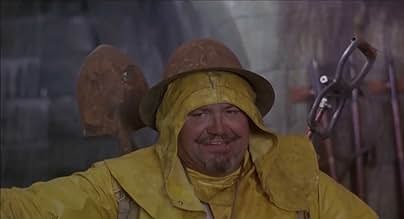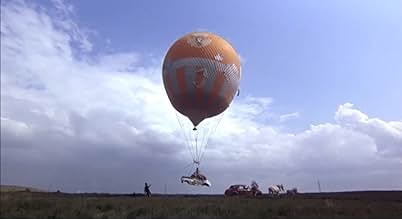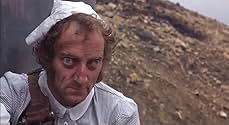PUNTUACIÓN EN IMDb
6,0/10
2,8 mil
TU PUNTUACIÓN
Añade un argumento en tu idiomaPost-apocalyptic England. Survivors navigate surreal wasteland, mutating into inanimate objects. Girl living on train meets commuter and doctor. Follows their interactions amidst chaos, focu... Leer todoPost-apocalyptic England. Survivors navigate surreal wasteland, mutating into inanimate objects. Girl living on train meets commuter and doctor. Follows their interactions amidst chaos, focusing on girl's pregnancy.Post-apocalyptic England. Survivors navigate surreal wasteland, mutating into inanimate objects. Girl living on train meets commuter and doctor. Follows their interactions amidst chaos, focusing on girl's pregnancy.
- Dirección
- Guión
- Reparto principal
- Premios
- 2 premios y 3 nominaciones en total
Reseñas destacadas
This is a visually stunning, funny, brilliant, and extravagantly weird film that should best be compared to El Topo, Barbarella, Playtime, and the Cremaster series. It's the kind of movie made with a big studio budget and free artistic reign; a combination that existed in other late 60s and early 70s bombs that have become cult classics.
Imagine if Monty Python did a lot of LSD, spent a million dollars on art direction, and then made a nuclear-apocalypse satire. Each shot is as sumptuous and symbolically rich as any Mathew Barney created - what with middle class Brits walking on a field of broken china, Underground escalators that end in mid-air, and Cathedrals submerged in water. Plot-wise, this is as free-of-field as an experimental film. Whether you think it profoundly beautiful or profoundly ugly, the look is in the Quay brothers'/Dubuffet mold. Its narrative loosely strings together amazing images, costumes, and poignant, often hilarious scenes of British society desperately trying to hold on to any remaining shards of civilization. The Bed Sitting Room is full of sarcastic comments and profound notions. It is not full of plot - it's amazing without it.
If there is any chance to see this movie on screen, take it. Any frame is worth the price of admission.
Imagine if Monty Python did a lot of LSD, spent a million dollars on art direction, and then made a nuclear-apocalypse satire. Each shot is as sumptuous and symbolically rich as any Mathew Barney created - what with middle class Brits walking on a field of broken china, Underground escalators that end in mid-air, and Cathedrals submerged in water. Plot-wise, this is as free-of-field as an experimental film. Whether you think it profoundly beautiful or profoundly ugly, the look is in the Quay brothers'/Dubuffet mold. Its narrative loosely strings together amazing images, costumes, and poignant, often hilarious scenes of British society desperately trying to hold on to any remaining shards of civilization. The Bed Sitting Room is full of sarcastic comments and profound notions. It is not full of plot - it's amazing without it.
If there is any chance to see this movie on screen, take it. Any frame is worth the price of admission.
Just two years after the end of the 'frightened fifties', Spike Milligan wrote the play "The Bed Sitting Room", a black comedy about life in post-apocalyptic London and, in 1969, Richard Lester directed this film version. The film is essentially an interconnected series of absurdist sketches featuring some of England's best known comedians playing survivors in the radioactive aftermath of a two minute war (the "nuclear misunderstanding"). In the film's off-kilter reality, mutations are causing dramatic changes to people, including Lord Fortnum's (Sir Ralph Richardson) literal metamorphosis into the titular room and 'Mother's' (Mona Washbourne) change into a wardrobe (setting up the line "Get your hands out of my drawers!"). These strange events are all monitored by the Police Inspector (Peter Cook) and his Sergeant (Dudley Moore), either from their balloon-lofted Morris Minor or their wreaking-ball equipped bulldozer. I found the film is more fascinating than funny: some of the humour I liked (such as the BBC host) but some resembled forgettable Monty Python sketches (the Underwater Vicar comes to mind). The strange, bleak and sometimes surreal settings are the best part of the film, especially the vast piles of shoes and of the mountain of broken crockery. Apparently in a 1988 interview, Milligan said that the play was his way of saying that after the apocalypse life would just go on, with all of its absurdities intact. If that was indeed the raison d'être for the film, it was completely lost on me and I have no idea what other viewers will make of this strange, dated yet oddly compelling pitch-black farce.
Buried in the sheer oddity and downright perversity of the humour there is a deep pathos. People of all classes from Lord to lunatic try through activities and language to cling to a civilization represented by heaps of objects. The horrors of holocaust are tempered by humour arising mainly from the ridiculous pretensions of the cast. Every mainstay of British middle and upper class culture has been made absurd - some of the characters are busy mutating into absurd objects - a bed sitting room, a wardrobe, a parrot. The humour is zany, the one-liners often mixing double entendre, understatement and naievity with real pathos. Arthur Lowe as the pompous father, Mona Washbourne as the all-sympathetic mother can bring a lump to the throat.
The nearest rival to Milligan's and Antrobus' satire is to be found in Swift. Lampooning society after it has endured the very worst of tragedies and demonstrating through a torrent of absurdities, that human decency survives is something difficult to sustain in text, but this Fellini-like panorama could never be contained by the pages of a book. It almost defines one of the things which film can do best.
It is ragged and patchy - but a film which includes Harry Seacombe as a 'regional seat of government' defies conventional criticism!
The nearest rival to Milligan's and Antrobus' satire is to be found in Swift. Lampooning society after it has endured the very worst of tragedies and demonstrating through a torrent of absurdities, that human decency survives is something difficult to sustain in text, but this Fellini-like panorama could never be contained by the pages of a book. It almost defines one of the things which film can do best.
It is ragged and patchy - but a film which includes Harry Seacombe as a 'regional seat of government' defies conventional criticism!
A very strange film, this one, a surreal post-apocalypse comedy with some broad satire aimed at British politics and culture. It's quite unmissable on account of the incredible cast of famous faces and worth seeing just for them doing their bit, but the rest is more of a sketch show than anything else. It's moderately funny, on par with a typical MONTY PYTHON episode of the era.
After the grim realism of Peter Watkins' 'The War Game' this film marked the sixties' headlong retreat into total fantasy in which the Central Line still functions and radiation causes mutation into a bed-sitting room rather than boring old radiation sickness.
An amazing cast (including two Goons) make complete fools of themselves in the film in which Dick Lester blew once and for all the professional capital he'd made directing the Beatles. Ken Thorne's music like the rest of the film is likeable but far too emphatic.
An amazing cast (including two Goons) make complete fools of themselves in the film in which Dick Lester blew once and for all the professional capital he'd made directing the Beatles. Ken Thorne's music like the rest of the film is likeable but far too emphatic.
¿Sabías que...?
- CuriosidadesProducer and director Richard Lester is said to have been depressed that many of the outdoor locations were found so quickly, and needed so little modification.
- PifiasA London Underground train appears several times. The legend over the cab states 'Circle' as in Circle Line. But the Circle is a sub-surface line while the train depicted is London Underground 1962 deep line stock.
- Créditos adicionalesIn the opening credits, cast members are listed in order of height.
Selecciones populares
Inicia sesión para calificar y añadir a tu lista para recibir recomendaciones personalizadas
- How long is The Bed Sitting Room?Con tecnología de Alexa
Detalles
- Fecha de lanzamiento
- País de origen
- Idioma
- Títulos en diferentes países
- The Bed Sitting Room
- Localizaciones del rodaje
- St Austell, Cornwall, Inglaterra, Reino Unido(china clay pits)
- Empresa productora
- Ver más compañías en los créditos en IMDbPro
- Duración1 hora 30 minutos
- Color
- Relación de aspecto
- 1.66 : 1
Contribuir a esta página
Sugerir un cambio o añadir el contenido que falta

Principal laguna de datos
By what name was La sala de estar con cama (1969) officially released in India in English?
Responde



































